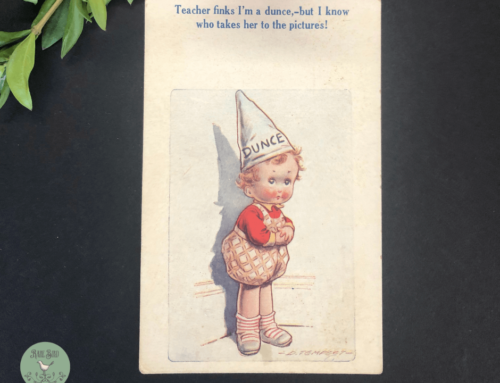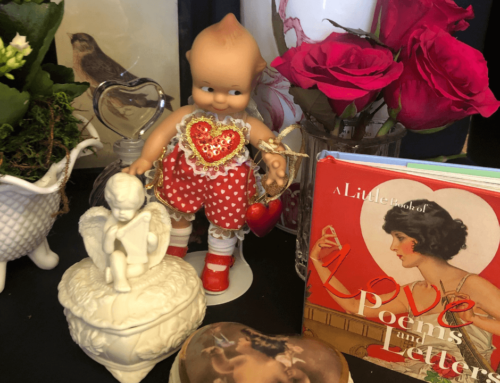
Vintage Valentine’s Day cards available at Rare Bird Antiques.
There are really only 2 holidays that center around exchanging greeting cards – Christmas and Valentine’s Day. To understand when the practice of exchanging Valentine’s Day cards began, we have to look back to how the holiday itself got started. We can trace the roots of Valentine’s Day back to two ancient Roman festivals. Februa, which is where the month got its name, was a cleansing ritual that took place on the 15th of February. This festival evolved into the pagan festival of Lupercalia, which was meant to secure fertility and bounty for the coming year.
Valentine’s Day – A Religious Holiday

St, Valentine – Public Domain
Valentine’s Day got its name from St. Valentine. He was a third century priest of the Roman empire. He ministered to persecuted Christians. He continued to marry couples despite a ban on marriage declared by Emperor Claudius II. Claudius believed single men made better soldiers. Valentine was martyred and buried on February 14th and this day became known as the Feast of St. Valentines. For hundreds of years, it was just a day of honoring a martyred priest, but centuries later St. Valentines Day became linked with romance.
Romance Linked to Valentine’s Day
This romantic link is attributed to the British poet Chaucer. Around 1382, Geoffrey Chaucer wrote a line in his poem “Parlement of Foules” which was:
“For this was on seynt Valentynes day Whan every foul cometh ther to chese his make.”
In modern language, this means “when every bird comes to choose its mate on St. Valentine’s Day.” In the Middle Ages, it was commonly believed that birds chose their mates in February (hence the use of love birds as a motif for the holiday). Valentine greetings date back to the Middle Ages, but a written Valentine didn’t appear until the early 1400’s.
The First Valentine Message

Charles d’Orleans, Poetry; Pseudo-Heloise, Epistles; ‘Les demands d’amours’; ‘Le livre dit grace entiere’ – Public Domain
This first documented romantic missive was from Charles, Duke of Orleans to his wife, Bonne of Armagnac. Charles wrote the Valentine while he was imprisoned in the Tower of London. He was captured during the Battle of Agincourt in 1415. The Duke repeats several times the phrase “Valentine” as a term of endearment in his poem.
“Je suis desja d’amour tanné, Ma tres doulce Valentiée.”
In English, it translates to “I am already sick of love, My very gentle Valentine.” Unfortunately, his wife died before receiving the love poem and it can be found in the British Library today.
Handwritten Valentines
Pre-made cards were not available in the 1700’s, but we began to see hand-made cards, These hand-made cards were usually delivered in secret by slipping them under a loved one’s door. If you were at a loss for words, no worries, there were verse guides you could purchase to help guide your pen and woo your Valentine. The Young Man’s Valentine, Saint Valentine’s Sentimental Writer, and the Introductory Treatise on the Composition of a Valentine by a Master of Hearts were available throughout England and America for gentlemen. For the ladies, The Lady’s Own Valentine Writer and People’s Valentine Writer by a Literary Lady were published.

Oldest Printed Valentine’s Day Card – Courtesy of York Museums Trust
Oldest Printed Valentine
The oldest printed card believed to be in existence was printed in 1797 in London. It is in the York Castle Museum in York England. The card is hand colored and features florals, cupids and doves. A verse –
“Since on this ever Happy day, All Nature’s full of Love and Play. Yet harmless still if my design, ‘Tis but to be your Valentine”
appears around the floral border.
Mass-Production of Valentines
With the Industrial Revolution and the development of the printing press came the mass production of Valentine Cards. Common motifs of florals, cupids, hearts and birds are used to illustrate the cards and the tradition of exchanging cards with lovers, friends and family became entrenched.

Esther Howland, known as the “Mother of American Valentines.” Courtesy of Mount Holyoke.
Esther Howland published the first American Valentine’s Day Card in Worcester, Massachusetts. She created a company where she designed the initial prototype, and a factory of girls would then assemble the finished product. Each card was a piece of art and sold for more than $5 each in 1849. Esther Howland is known as the “Mother of American Valentines” and is credited with commercializing Valentine’s Day cards according to Time. By 1880, the New England Valentine Company was raking in over $100,000 in profits. This would be $2.5 million dollars in today’s money. You go Esther! Her cards are highly collectible. Many of her Valentine’s Day cards are preserved and on display every February at her alma mater, Mount Holyoke in their Archives and Special Collections.

“Sincerely Yours” Valentine Day card made by Esther Howland, circa 1870’s.

Vintage school Valentine’s Day cards available at Rare Bird Antiques.
Hallmark, the famed greeting card company, (initially Hall Brothers) first offered Valentine’s Day cards in 1913 and began producing them in 1916. According to Hallmark, 145 million Valentine’s Day cards are exchanged each year and this does not include all the packaged Valentines kids share in their classrooms.
So, there you have it. A brief explanation of the history of Valentine Cards. We hope you learned something new and have a greater appreciation for the art form.



